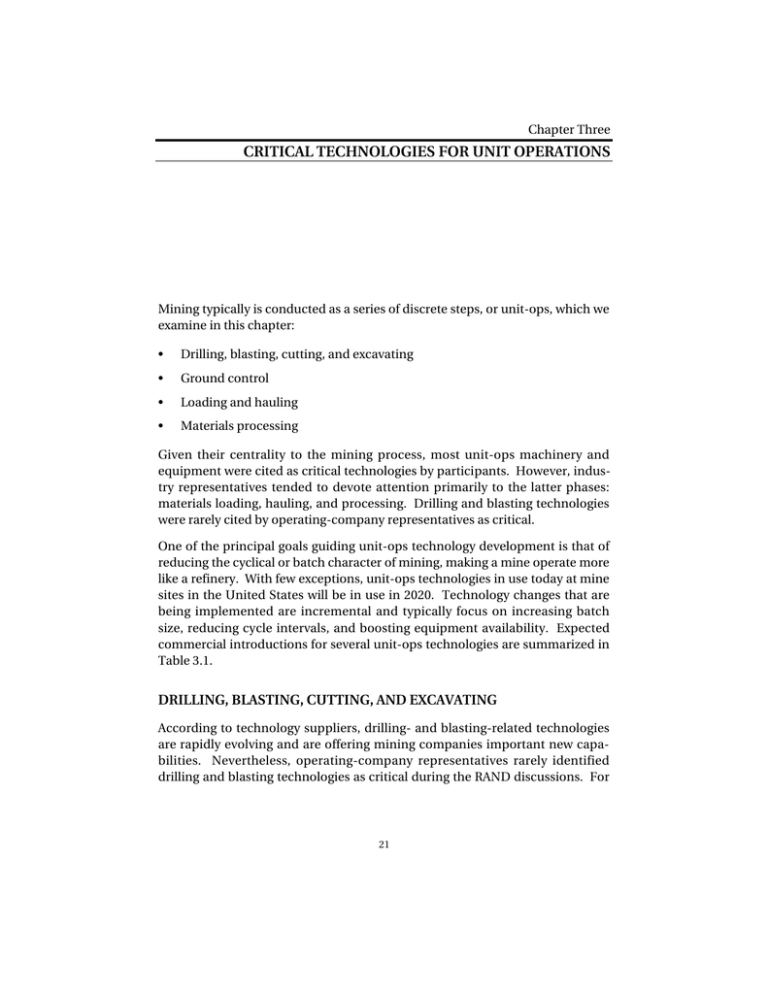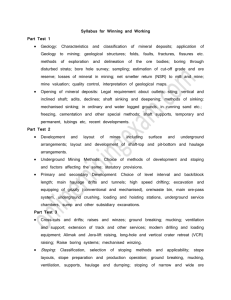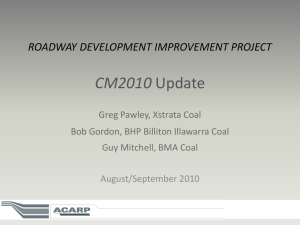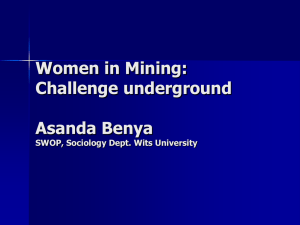CRITICAL TECHNOLOGIES FOR UNIT OPERATIONS
advertisement

Chapter Three CRITICAL TECHNOLOGIES FOR UNIT OPERATIONS Mining typically is conducted as a series of discrete steps, or unit-ops, which we examine in this chapter: • Drilling, blasting, cutting, and excavating • Ground control • Loading and hauling • Materials processing Given their centrality to the mining process, most unit-ops machinery and equipment were cited as critical technologies by participants. However, industry representatives tended to devote attention primarily to the latter phases: materials loading, hauling, and processing. Drilling and blasting technologies were rarely cited by operating-company representatives as critical. One of the principal goals guiding unit-ops technology development is that of reducing the cyclical or batch character of mining, making a mine operate more like a refinery. With few exceptions, unit-ops technologies in use today at mine sites in the United States will be in use in 2020. Technology changes that are being implemented are incremental and typically focus on increasing batch size, reducing cycle intervals, and boosting equipment availability. Expected commercial introductions for several unit-ops technologies are summarized in Table 3.1. DRILLING, BLASTING, CUTTING, AND EXCAVATING According to technology suppliers, drilling- and blasting-related technologies are rapidly evolving and are offering mining companies important new capabilities. Nevertheless, operating-company representatives rarely identified drilling and blasting technologies as critical during the RAND discussions. For 21 22 New Forces at Work in Mining: Industry Views of Critical Technologies Table 3.1 Anticipated Availability of Selected Unit-Ops Innovations Technology Solid-state programmable blast detonators Six-unit miner-bolters Mechanical cutter for hard-rock applications Fuel-cell-powered underground equipment 1000-ton-capacity haul truck 150-cubic-yard-capacity shovel Anticipated Date 2000 2000 2003 2010 2020 2020 Source: RAND discussion participants. one supplier in particular, this disparity in perceptions appeared to preclude important productivity-enhancing opportunities. The most significant changes in blast technology address product-delivery systems. One factor is the continuing trend away from the use of cartridged products in favor of bulk products for both surface and underground operations. Representatives mentioned new surface and underground delivery-vehicle technologies that boost blast accuracy and safety: high-precision pumps and blending and measurement devices, robotic arms that place the product in the hole, and remote controls. The integration of IT is also improving blast optimization capabilities through in-field measurement and reporting of loading information and blast results such as particle size, heave, and distribution. (This subject is discussed further in Chapter Four.) A third trend is outsourcing of blasting-related services, ranging from consulting on safety to providing comprehensive packages priced according to the volume of “shot rock” on the ground or ore processed. As a result of these blast-optimization efforts, the volume of blast agents per unit of shot rock is slowly decreasing. The standard blasting agent throughout the industry remains ammoniumnitrate-based emulsions, and this basic explosives chemistry is unlikely to change in the coming two decades.1 While alternative blasting agents (e.g., water gels) are available, they are rarely used in mining because of their higher cost (three to four times the cost of conventional emulsions). When considering blasting technologies, operating companies tend to be highly costconscious, which mitigates opportunities to develop value-added or innovative products. Two explosives representatives noted that quarry operations, though a smaller share of their business than coal and metals operations, offer greater ______________ 1 One supplier noted that ammonium-nitrate emulsions accounted for 90 percent of their explosives sales in the United States. Critical Technologies for Unit Operations 23 opportunities for higher-margin business relationships due to operators’ desire to expand capacity. Explosives are a mature technology and have become a commodity product, motivating suppliers to look at the entire blasting-related value chain for opportunities to capitalize on their expertise. As a result, providers are shifting their business focus from products to service. • One technology supplier has signed a covenant to pursue “special projects” with a long-time customer to improve the latter’s coal-production processes. The partners have agreed to share the profits. This arrangement resulted from “a paradigm shift” in the coal company’s view of the value of outside expertise. • Arguing that blasting generally is conducted according to rules-of-thumb dating back to the 1950s, one supplier noted his firm’s ability to draw on its database of over 20,000 blast configurations to help mining companies optimize their blasting and reduce their haulage and processing costs. A small number of participants cited solid-state programmable blast detonators as an important technology that is currently coming to market. Advantages include more-precise delay timing (resulting in increased blast efficiency and control) and greater compatibility with remote-controlled loading of explosives and wireless detonation. However, these initiating systems have significantly higher costs, and none of the participants reported routinely using them. A future niche market may be in-town quarries under pressure to reduce off-site vibration and noise impacts. Several operating companies and technology and service providers expressed concern about nitrogen-oxide (NOx) releases from blast sites and their potential health impacts on workers, as well as their aesthetic and environmental impacts on nearby communities.2 These concerns may increase as bulk mining of metals and cast-blasting in surface coal operations become more prevalent. But one blasting specialist noted that NOx releases are rare and that there has been no reliable quantification of occupational or ambient impacts. After many years, continuous miners and longwall systems remain the principal underground coal-extraction technologies in the United States, the output from both methods accounting for more than 90 percent of all underground coal produced. Output from longwall coal-production systems in the United States surpassed output from continuous mining systems in 1994, and, given the con______________ 2 NO is released as a result of incomplete combustion due to the lack of proper confinement or the x incursion of water into the blasting agent. These problems are being addressed through advances in blast modeling and design. An operating-company executive noted that residual nitrates also have the potential to contaminate groundwater. 24 New Forces at Work in Mining: Industry Views of Critical Technologies tinuing growth of longwall panel productivity, the share of underground coal output produced by longwalls is likely to continue to grow for the foreseeable future. A few incremental enhancements were mentioned by study participants. Longwall panel dimensions increased substantially in the United States during the 1990s: Average face widths increased from 600 to 1,000 feet, and panel lengths grew from 5,000 to 7,500 feet. State-of-the-art systems currently have face widths of over 1,200 feet. According to one coal-company representative, extension of longwall widths is limited primarily by the capabilities of the face conveyor to pull coal over longer distances: Space constraints limit the size of drive units, and existing materials and engineering capabilities limit the strength of drive chains. Additional increases in drive output will require supplying higher voltages at the face (above the current 4,200-volt peak standard) and may present a greater safety hazard, namely, fire and electrocution. Other technology constraints to further boosting longwall productivity include horizon control, ground control, and ventilation. During the RAND discussions, rock-cutting technologies were identified as a promising area for innovation. • A member of the research community noted that an “oscillating disk cutter” was in the early stages of development and may be available to the mining industry by 2010. Another researcher, however, disparaged prototype demonstration efforts and claimed that the basic concept—in which the cutter strikes the rock—was unworkable. • A technology supplier reported that a continuous mechanical cutter his firm was developing was “on the edge of breaking through the [feasibility] envelope” and would be commercially available by 2003. The technology, which entails specially hardened conical picks laced on a cutter head, was most likely to see its first U.S. production applications in the Carlin Gold Belt of Nevada. • Tunnel-boring machines are an alternative, albeit more costly, rock-cutting technology occasionally used in mining. An underground metal operation reported that it was using a commercial tunnel-boring machine to develop a major drift as the mine transitions from surface to underground operations. • An aggregates-company executive noted that his firm was seeking to develop and deploy machinery that cuts hard rock in a fashion similar to that of pipe-trenching and marine dredging equipment. Several discussants raised the issue of mechanical cutting of hard rock as an alternative technology to blasting.3 As has been experienced with coal and other ______________ 3 Mechanical cutting technologies for soft-rock materials such as phosphates and trona have been commercially available for several decades. Critical Technologies for Unit Operations 25 soft minerals, mechanical cutting of hard rock would play a critical role in eliminating the batch processing character of drilling and blasting and would also produce more uniform particle size. In addition, reduced shattering and shock damage to surrounding material would reduce ground-control requirements in underground operations. The need to find an alternative to blasting to reduce percussive noise at in-town locations is driving a search for rock-cutting technologies for the quarry industry. The key constraint in developing such technologies, an executive noted, is the problem of raising the compressive strength of head wear materials enough to cut consistently and economically through the range of rock found in a mine. Other technology challenges are the mitigation of noise and dust generation. GROUND CONTROL Ground control was most commonly cited as the unit operation undergoing the most important technological innovation in underground environments. Miner-Bolters The majority of ground-control operations in underground mine development are accomplished through rock-bolting. Accordingly, the introduction of a new generation of combination continuous-miner/bolters was raised as an important innovation. Standard commercial miner-bolters consist of a continuous miner equipped with two bolting units and require three to four operators. New-generation miner-bolters have six bolters (four roof units and two wall units) that operate while the continuous-miner cutting barrel is advancing. These new miner-bolters require as few as two operators. They are presently available from one European manufacturer, and a U.S. manufacturer is scheduled to release a model in late 2000. New-generation miner-bolters are likely to have a major influence on both the method by which coal-mine entries are developed in the future and the speed of those developments, according to industry representatives. Because the new miner-bolters complete all the required bolting on the first pass of the equipment, no time is wasted cycling machinery, support equipment, and supplies in and out of entries.4 In principle, the machines do not need to stop until the entry is complete. In practice, however, other constraints (e.g., coal removal, ventilation, bolt and resin supply, machine reliability) may become limitations at some point. ______________ 4 Presently, entry development typically proceeds by place-changing (or “cut and flit”): A continuous miner (with no bolting capability) advances 20 to 40 feet and then must retreat from the entry (at which point it begins cutting in a different area) and be replaced by a bolting team. 26 New Forces at Work in Mining: Industry Views of Critical Technologies Cable Bolts A second important ground-control innovation is cable-bolting for primary support. Cable bolts—constructed from multistrand steel cable—have been an important ground-control technology for several years, primarily as a form of supplemental roof support.5 Industry participants noted that cable bolts, because of their significantly higher tensile strength and resistance to shear failure relative to solid rod bolts, permit greater bolt spacing; they also reduce—and in some cases may eliminate—the need for supplemental support. This reduces material costs and development times and improves productivity by minimizing the jockeying of equipment. Indeed, the productivity benefit realized in the transition to cable bolts may be on a scale comparable to that of the transition from timber to bolting, said one discussant. Cable bolts will become increasingly attractive as mines continue to go deeper and supplemental support requirements increase. Primary cable-bolting presently is employed in one longwall coal mine. Because the surface area of cable bolts is much higher than that of solid rod bolts, general-use approval of cable bolts is contingent upon demonstrating longterm corrosion resistance. The latest designs, which incorporate epoxy coating and galvanization, may provide adequate resistance. Some participants claimed that the use of cable-bolting also may facilitate remote-control or semiautonomous bolting when bulk bolt material is stored on a spool. Spray Coatings A third trend in ground control, primarily in metals mining, is the increasing use of spray coatings in primary-support applications. Concrete spray coating (shotcrete or gunnite) traditionally has been used for roof-support rehabilitation and repair, but its application as a primary roof support may increase due to the availability of new sprays featuring advanced concretes, polymers, epoxies, and fiber reinforcements. According to manufacturers with whom we spoke, these coatings are not necessarily meant to replace bolting; rather, they are intended to provide more flexibility in meeting roof-support needs. Shotcrete, for example, may be used in conjunction with bolts to eliminate screening, permit wider bolt spacing, and decrease bolt length. Polymer or composite coatings, while contributing little structural support, provide a watertight seal on the rock surface, reducing the roof’s susceptibility to chemical weathering and degradation. ______________ 5 Supplemental support entails additional bolting in a previously supported area. This may be required as a result of excavation elsewhere in the mine altering the local stress field. Critical Technologies for Unit Operations 27 Synthetic reinforcement fibers for spray coatings. Fibers are one of a number of new technologies that enhance the strength and durability of shotcrete, enable its use as a primary roof support, and reduce snag injuries to personnel. Suppliers noted that an advantage of spray coatings is the ability to install support sooner after blasting than is possible with bolts. In addition to decreasing the production cycle time, rapid application apparently preempts the critical stage of initial roof sagging and “fools the rock” into needing less support. Another cited advantage of spray coatings is the ease with which they can be applied via remote operation, thereby eliminating the need to have an operator working under an unsupported roof. Manufacturers and mining-company representatives indicated that the use of primary shotcrete in underground metal mines is increasing. But while manufacturers have made a strong case for the benefits of spray coatings for primary support, this technology is still used in only a small fraction of operations. The widespread use of polymer coatings has been limited because of concerns about health and fire hazards. These problems may be circumvented, however, with the recent introduction of a new generation of composite concretepolymer materials. 28 New Forces at Work in Mining: Industry Views of Critical Technologies LOADING AND HAULING Haul trucks, shovels, and excavators are typically cited as the most critical technologies for surface-mining operations and are the units around which most mining operations are designed and planned. The most significant technology innovations, from the perspective of the executives with whom we spoke, are incremental and address load capacity and reliability. In the late 1990s, four haul-truck manufacturers broke through the 300-ton barrier, and truck manufacturers are expected to increase the capacity of trucks even further in the future. “Super-size” 400-ton trucks are currently in testing,6 and one supplier predicted that by 2020, 1,000-ton-capacity haul trucks will be commercially available.7 As trucks scale up over the coming years, so will excavators—from the current 50-cubic-yard rating to 150 cubic yards. A 50-cubic-yard electric shovel loads a 240-ton haul truck in three passes. The scale-up of excavators is expected to follow in tandem with the scale-up of haul trucks. ______________ 6 One coal producer reported having three 400-ton trucks in operation. 7 One participant claimed that the latest increases in haul-truck ratings are misleading: Some models rated at 340, 360, and 400 tons, for instance, are of the same basic technology as 320-ton trucks. Manufacturers simply upgraded the rating in response to de facto usage patterns of mining companies. Critical Technologies for Unit Operations 29 At quarry operations, the standard haul-truck capacity has increased from 35 to 50 tons over the past several decades. Now, 85- and 100-ton trucks are in use at some facilities in this segment, said a discussant. This capacity-growth trend is likely to continue as older, smaller, in-town quarries are closed in favor of larger, more remote operations. Few major changes were reported in underground haulage systems. The most critical change with load-haul-dump (LHD) vehicles, said one executive, is the horsepower-to-weight ratio, which is boosting tramming speed on grades. This has particular salience for mines that are converting from surface to underground operations and that use inclined drifts. A continuing trend away from tethered (electrical) underground equipment was expected by one discussant. Two discussants raised the merits of alternatives to diesel equipment, e.g., hybrid diesel-electric battery systems and natural-gas engines. Fuel-cell technologies were seen by five discussants as encouraging, and one equipment manufacturer asserted that fuel-cell-powered underground equipment would be available by 2010. The study participants highlighted performance enhancements and constraints associated with critical subsystems. One participant drew attention to the importance of faster-cycling hydraulic systems: Hydraulic systems are being reengineered (e.g., by reducing the number of cylinders) to reduce the cycle time of loaders, excavators, and haul trucks. Truck tires are a critical subsystem technology influencing the development of heavy haul trucks. • Several participants cited tire load and speed ratings as the main factors (functions of tire materials and construction) limiting the scale-up of haul-truck capacity. Also, as tires increase in size, they impinge on the ability of truck manufacturers to build structurally sound frames. • Tires were cited by one executive as the principal productivity bottleneck for his firm’s mining operations. • Other tire-related concerns raised by discussants were cost and disposal. A tire manufacturer reportedly is developing a three-piece modular tire design that will reduce manufacturing and maintenance costs. A prominent debate that emerged during the discussions concerned the appropriate scale of loading and hauling equipment, especially for surface mining. Reviewing the rapid increase in truck and excavator capacity over the past several decades, some participants argued that increases in equipment scale, when appropriately applied, tend to boost productivity. Several mining and quarrying executives and technology providers looked forward to the continuing 30 New Forces at Work in Mining: Industry Views of Critical Technologies scale-up of haul trucks, loaders, and excavators and the expected economies this scale-up would bring. However, some participants questioned whether the size of haul trucks and excavators has reached a feasibility threshold where the economies of scale have peaked. They raised several issues: • Haul-truck size has physical limitations, including space constraints on the further scale-up of drivetrains and the need to maintain structural integrity of equipment bodies. • Increased equipment size results in greater production and transportation costs, greater numbers of pieces that must be shipped to the site, and longer field assembly times. • Scaled-up equipment requires extensive facility reengineering: Bigger trucks require heavier-duty haul roads and bigger maintenance sheds and must be paired with larger-capacity excavators. • There appear to be no near-term breakthroughs in tire load capacity. • A de facto size limit is imposed by the number of shovels in operation: Most facility managers would like to keep at least three shovels operating, for enhanced flexibility and reliability. One participant cited a need to focus on alternative ways of increasing truck capacity and efficiency, such as developing lighter-weight truck bodies, highercapacity wheel bearings, and higher-volume truck beds. Shovel sizes are nearing the point at which the roller circles on which the machine turns can no longer be shipped easily in one piece. Beyond the added shipping demands, field assembly of this part involves welding and subsequent machining, an expensive and time-consuming step that requires specialized tooling and personnel onsite. —Equipment manufacturer Where feasible, underground and surface mines are replacing track and truck haulage with belt-haul conveyors, which have a lower operating cost (see Table 3.2). Coal companies in particular highlighted the increasing use and importance of conveyors. The conversion to belt haulage systems was listed as one of the top three current mine-site investment priorities of one major coal producer. Another coal producer argued that running belts through mined-out tunnels was more flexible and cost-effective than building and maintaining sur- Critical Technologies for Unit Operations 31 Table 3.2 Belt and Truck Haulage Costs Method Truck haulage Conventional belt haulage Automated belt haul and stacking Cost (cents per ton/mile) 15–35 5–10 1–15 Source: Industry representative. face roads, and that it reduced labor costs in the mine. He described his company’s operations as now having “a tremendous amount of belt structure.” MATERIALS PROCESSING8 One major metals producer cited ore crushers as an important weak link in his company’s operations. Anomalous incidents, such as the accidental introduction of a shovel bucket tooth, were cited as a major issue with which he had to contend. Crusher reliability is especially critical, because an interruption in downstream operations can be very costly. Many aggregates producers are deploying mobile crushers and screeners to ramp up production to meet steadily growing demand stimulated by rapid growth in federal and state transportation spending as well as the strong demand in the construction industry. Other goals are to manage production capabilities among a firms’ various quarry operations more flexibly and to provide local dedicated capacity on-site at large-infrastructure projects. Although they add flexibility, mobile crushers have relatively short working lives and require maintenance overhauls after seven to 10 years, according to one representative. Vertical impactors are gradually replacing cone crushers in the aggregates industry to boost throughput and to allow operators to meet increasingly tight buyer specifications that call for aggregates of a consistent “clean” grade and more precise shape.9 However, the operating temperatures and throw rates of vertical impactors are higher than those of cone crushers. Vertical impactors ______________ 8 This study focused on materials-extraction activities at the mine site. But in some discussions, most notably those with aggregates producers, materials processing was seen as an important mine-site activity. 9 Road-building standards and contracts in the United States increasingly call for the use of Superpave, a high-performance asphalt that uses cubical rather than conventional oblong-shaped aggregate. 32 New Forces at Work in Mining: Industry Views of Critical Technologies also tend to have shorter wear lives (five to 10 years) and require more-frequent overhauls. Several discussants noted the trend toward greater use of leaching processes for winning metals from oxide as well as sulfide ores. Two drivers were identified: the decreasing availability of high-grade ore in the United States, and the growing capabilities for bulk ore handling and processing. One technology highlighted by a discussant is a reusable leach pad serviced by an automated “race track” ore-stacking, leaching, and bucket-wheel harvesting system. According to the technology provider, the automated system boosts ore recovery rates from approximately 30 percent to between 85 and 90 percent while significantly reducing energy and labor costs. The continuous, conveyor-fed process also reduces costs associated with conventional batch (truck) haulage and stacking.







